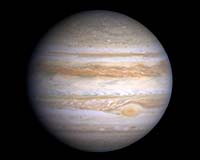 Cassini Captures Jupiter's Giant Storms
Cassini Captures Jupiter's Giant Storms

Cassini Photo Release: This true color image of Jupiter is composed of three images taken in the blue, green and red regions of the spectrum. All images were taken from a distance of 77.6 million km on October 8, 2000, around 16:57 UTC/SCET (spacecraft event time). The resolution is 466 km. Different chemical compositions of the cloud particles lead to different colors; the cloud patterns reflect different physical conditions -- updrafts and downdrafts -- in which the clouds form. The bluish areas are believed to be regions devoid of clouds and covered by high haze. The Great Red Spot (below and to the right of center) is a giant atmospheric storm about 2 Earths across and over 300 years old, with peripheral winds of 300 miles per hour. This image shows that it is trailed to the west by a turbulent region, caused by an atmospheric flow around the northern perimeter of the Spot. The small very white features in this region are lightning storms, which were seen by the Galileo spacecraft when it photographed the night side of Jupiter. Cassini will track these lightning storms and measure their lifetimes and motions when it passes Jupiter in late December and looks back at the dark side of the planet.
Credit: NASA/JPL/UoA
Image Preparation: Dyer Lytle
Image Design: Carolyn Porco
|
Pasadena - Oct. 24, 2000
For the first time, scientists have been able to watch the process of two of Jupiter's giant "white oval" storms, each about half the size of Earth, colliding and merging to form an even bigger storm.
"Usually when we've seen two of them approaching each other, they bounce back away from each other," said Dr. Glenn Orton, senior research scientist at NASA's Jet Propulsion Laboratory, Pasadena, Calif., and member of a team of Spanish, French and American astronomers that used NASA's Hubble Space Telescope and ground-based telescopes to study the ovals this year.
Dr. Agustin Sanchez-Lavega, an astronomer at Universidad del Pais Vasco, Bilbao, Spain, reported the team's observations today at the meeting of the American Astronomical Society's Division of Planetary Sciences in Pasadena.
The researchers speculate that a similar merger took place centuries ago and may have built Jupiter's famous Great Red Spot, a storm that is twice as wide as the Earth and has persisted in Jupiter's southern hemisphere for more than 300 years.
Seeing the collision of two storms will help scientists understand more about the dynamics of Jupiter's atmosphere, Sanchez-Lavega said. One question has been how deeply the roots of a storm at Jupiter's cloud tops extend into lower layers. In this year's merger, the upper layer seemed to move differently than underlying clouds.



| The content herein, unless otherwise known to be public domain, are Copyright 1995-2006 - SpaceDaily.AFP and UPI Wire Stories are copyright Agence France-Presse and United Press International. ESA PortalReports are copyright European Space Agency. All NASA sourced material is public domain. Additionalcopyrights may apply in whole or part to other bona fide parties. Advertising does not imply endorsement,agreement or approval of any opinions, statements or information provided by SpaceDaily on any Web page published or hosted by SpaceDaily. Privacy Statement |
|
